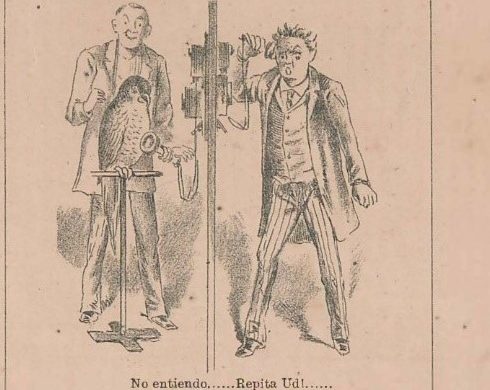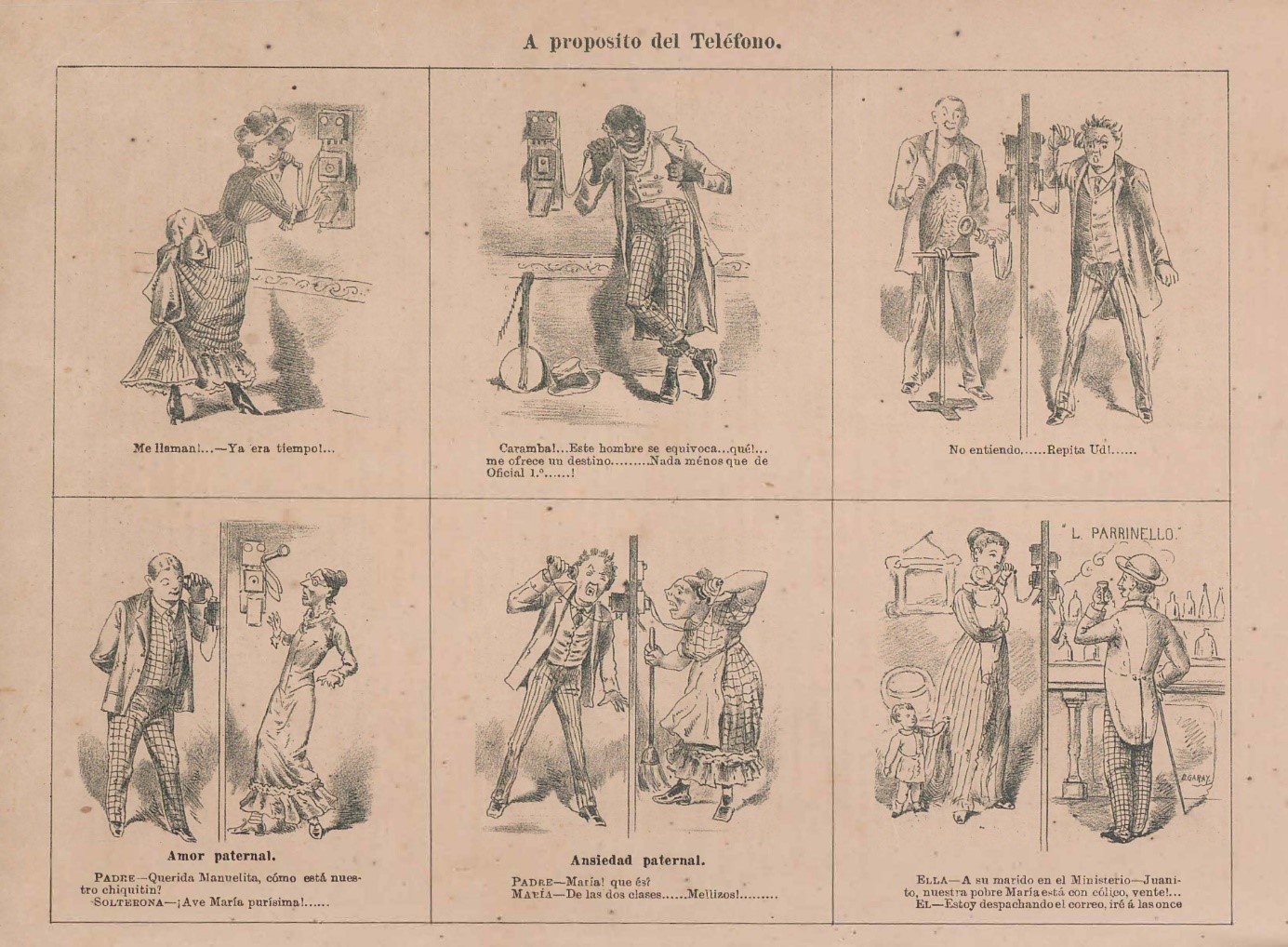
Fear, Curiosity and New Social Rules: Representations of Early Telephone Use in Latin America, 1880-1935
Technology’s Stories v. 8, no. 2 – DOI: 10.15763/jou.ts.2020.09.28.02
Berth_Fear Curiosity and New Social Rules
In the late nineteenth century, local governments began to install telephone lines in Latin American cities. Among the first countries to introduce telephone service were Cuba, Chile, and Mexico, all of whom did so in the 1880s. At first, the telephone was a medium of communication for urban elites. It entered government offices, enterprises, and a limited number of private households. Mexico City for example, published its first phone directory in 1888, with only 800 entries. Articles on the telephone, published in contemporary cultural magazines show that the new medium sparked both curiosity and fear among urban people.[1] Journalists responded with technical explanations and instructions for adequate use, along side caricatures and ads projecting their own views of telephone use. When technologies are new, theories about the social construction of technology suggest that many different people will be involved in negotiating how best (and properly) to use it. This essay will explore the fears and hopes about the telephone and how these articulated ideas about the what telephones are for, and how they should or should not be used. Theories of social construction of technology emphasize that this stage is one of “interpretive flexibility” where the meanings of new technoogies are not yet fixed. As different groups of people explore their fears and hopes, it becomes possible to better understand how a consensus about the purpose, meaning, and proper use of a technology came into being.[2] Magazines and newspapers were critical to the process.
Early fears and misunderstandings
The telephone opened new spaces for communication. It offered urban people opportunities for overcoming distance as well as crossing social or gender boundaries. At the same time, the new medium caused fear and curiosity. As the following illustration from a Peruvian cultural magazine in 1887 demonstrates, telephone calls were prone to misunderstandings and manipulation. This series of six drawings represent telephone conversations. Most images show the callers separated by a wall to indicate physical distance.

Figure 1: Telephone Use in late nineteenth century Peru. El Perú Ilustrado No. 19, September 17, 1887, 4. https://digital.iai.spk-berlin.de/viewer/image/818882093/4/LOG_0009/
On the first image in the bottom line, we see a man appearing in a suit using a telephone. The caption “Paternal love” introduces him as a father who calls the nanny to ask her about his son. The elderly women, characterized as unmarried in the caption, seems to be frightened and steps back from the telephone set exclaiming “Ave Maria”. This scene introduces the fear of inexperienced telephone users, notably portrayed as women, in juxtaposition with the skill and in this case, caring use by the sophisticated user, a man. Other drawings focus on problems originating from the invisibility of the conversation partner. For example, the last image on the left shows a couple. A husband is drinking in a bar with the telephone receiver hanging in the air. His wife, holding a baby in her arms, asks him to come home immediately, as her daughter has fallen ill. He claims to be at the post office and promises to come home soon. This drawing relates to the danger of manipulation in telephone conversations as the invisible other can hide his or her real activities or identity. A third image insists on that point, when one caller is substituted by a parrot. The man on the other side, unaware of his animal interlocutor, says: ‘I do not understand… Repeat please’
These illustrations are characteristic of coverage in Latin American cultural magazines around the turn of the century. The representations of telephone users usually include elite men and women communicating among each other or with their female employees. Their facial expressions show them experiencing fear and satisfaction while using the new medium. Their mouths indicate that they were shouting on the phone, a common practice among new telephone users who hoped to overcome distance through higher volume.
As novice telephone users navigated the emotional and communicative experience of the new technologies, it was not just the caller and the called who were involved. It also included vital intermediaries, the operators, who were required to place calls. Telephone users frequently complained about long wait times, operators’ rudeness or connection errors. But the context of these communication problems was often invisible to callers.
In the telephone exchanges the operators who manually connected calls were nearly always women. Company administrators hired women in part because they assumed women to be more skilled at connecting calls, due to their presumed adeptness at other fine tasks like needlework. Telephone companies also considered the female voice to be more pleasant for clients waiting to be connected; they trained operators systematically to adapt their voices to the companies’ needs.[3] In the early twentieth century, these operators suffered from a heavy workload. For example, in Mexico City an operator had to connect around 445 calls per day average, a volume that may have contributed to the long wait times that troubled customers.[4] Frequently, the firms urged operators to work more efficiently and avoid superfluous conversation with customers, which some callers may have interpreted as rudeness. Operators did not have an easy job. In several Latin American cities, operators went on strike in the early twentieth century to protest dismissals and strict vigilance in the workplace, exacerbating the frustration of callers. Without a fully shared understanding of acceptable and expected behavior and use, anxiety and social conflicts were unavoidable. Telephone companies and journalists reacted by producing education campaigns.
Idealized telephone use in magazines and advertisements
The Argentinean magazine Atlántida published a photo story in 1924 entitled “Do you know how to make a phone call?”. The caption states that pleasant telephone calls require “a good character, tolerance, and culture”. The caller is male and wears an elegant suit with tie. Once the operator answers, the caller should indicate the desired number with a clear and natural voice, at short distance to the receiver. In case the line is busy, the caller should stay calm and avoid yelling. This last admonishment probably referred to the experiences telephone companies had with uncouth behavior by their clients. Finally, the story shows an operator sitting at her switchboard. The caption reminded readers: “Always remember that there is a woman at the other end of the line. A good woman, generally, nearly always nice and pretty, who appreciates your politeness.” Instructions like these suggest that impolite, impatient or angry interactions with callers was probably common. They also tell us something about contemporary gender norms. At that time, women appeared mainly as mothers and homemakers with idealized characteristics, such as sweetness, elegance, and politeness.

Figure 2: Instructions for telephone use in Argentina, 1924. Source: Atlántida No. 348, December 11, 1924, 34 https://digital.iai.spk-berlin.de/viewer/image/863459501/34/
A new etiquette had to be established to provide contemporaries with a guideline for telephone conversations – both what they were for, and how they should be enacted. Cultural magazines like Atlántida and El Hogar played an important role in addressing these concerns for their elite and middle-class clientele. People discussed how to greet each other, if invitations via the telephone were appropriate and who should answer the phone in a household. Frequently, advice focused on the human voice. Most magazines reproduced prevailing conservative gender norms in their suggestions. Subordinate women with sweet voices served male users in establishing communication; a version that silenced telephone operators’ resistance and agency. Operators resisted their intense workload, strict control by supervisors, and short work breaks. They also demanded more flexibility in attending clients, for example by replacing standardized answers with personal attention.
Strict gender divisions also prevailed in multinationals’ advertisement as several examples from Mexico show. The Mexican branch office of the International Telephone and Telegraph Corporation (ITT) launched an advertising campaign portraying the telephone as absolute necessity. The ads introduce a situation when protagonists need a telephone using the headline “If I had a telephone…”. The desired item appears as a white silhouette on the drawing.

Figure 3: Advertising of the Mexican ITT branch. Source: La Familia No. 42, June 1935, p. 39.
In another series, the protagonists without a telephone lose an important opportunity. In the ad below, a young man has applied for a job. When the applicant admitted not to have a phone, this reduced his opportunities to obtain the job, argues the ad. These ads promised that the telephone would facilitate contacts with distant relatives, help in emergencies and accelerate professional success. They portray women mostly in private contexts while men are shown in at work with a telephone on their desk. The protagonists clearly represent an elite and middle-class clientele; employees are absent.

Figure 4: Advertising of the Mexican ITT branch. Source: La Familia, January 1938, 49.
Conclusion
During telephone conversations, telephone users in urban Latin America made new emotional experiences, including excitement, pleasure, or anxiety. Early on, talking to an invisible other mediated by operators provoked frequent misunderstandings. Whereas telephone users felt the need for individual attention, firms expected operators to attend customers in a quick, standardized way. These conflicts entered contemporary popular culture. Journalists published social rules for adequate telephone conversations and explained technical basics to their elite and middle-class readers. The visual representations of telephone users and operators tend to reproduce traditional gender roles, including self-confident male users, inexperienced female users, and subservient female operators. Most contributions portray women in traditional roles in private homes while men appear in their workplaces, In this way, although the telephone was entirely new, and brought with it novel work opportunities for women, the negotiations and representations of the telephone reinforced traditional gender roles in Latin American societies.
Christiane Berth, Ph.D. is Chair for Contemporary History at the University of Graz, Austria. Her research focuses on global economic and cultural entanglements among the fields of technology, development cooperation, food, consumption, migration, and trade.
Suggested Readings
Balbi, Gabriele and Christiane Berth, “Towards a Telephonic History of Technology,” History and Technology 35 no. 2 (2019): 105-114, https://doi.org/10.1080/07341512.2019.1652959.
Cuchí Espada, Víctor “Antes de ser compañeras: Gibson Girls mexicanas 1881-1911,” Secuencia 71 (2008): 65-80.
Hershfield, Joanne, “Domestic Technologies: Gender, Technology and Mexican Housewives, 1930-1950,” Technology and Culture in Twentieth Century Mexico, edited by Araceli Tinajero and Brian J. Freeman, 55-69. Tuscaloosa: Univ. of Alabama Press, 2013.
Martin, Michèle, “Hello Central?” Gender, Technology, and Culture in the Formation of Telephone Systems (Montreal: McGill-Queens Univ. Press, 1991).
Eli M. Noam (Ed.) Telecommunications in Latin America. (New York: Oxford University Press, 1998).
Pinch, Trevor J. and Bijker, Wiebe E., “The Social Construction of Facts and Artifacts: Or How the Sociology of Science and the Sociology of Technology Might Benefit Each Other,” The Social Construction of Technological Systems. New Directions in the Sociology and History of Technology, edited by Wiebe E. Bijker; Thomas Hughes and Trevor J. Pinch, 11-44. Cambridge MA: MIT Press, 2012.
Copyright 2020 Christiane Berth
Notes
[1] The Ibero-American Institute in Berlin provides an excellent digital collection of Latin American cultural magazines, where most of the articles quoted can be found: https://digital.iai.spk-berlin.de/viewer/collections/lateinamerikanische-kulturzeitschriften/
[2] Trevor Pinch, “The Social Construction of Facts and Artifacts.”.
[3] Martin, Hello Central.
[4] Cuchí Espada, “Antes de ser,” 72.
